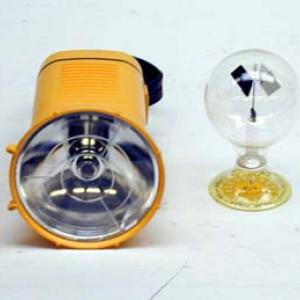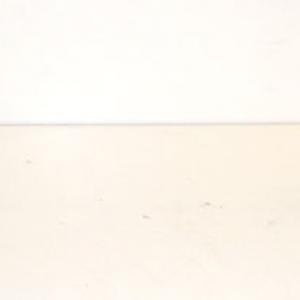College of Liberal Arts & Sciences
4D20.10 - Radiometer
See also 4D20.10 in Heat and Fluids.
The vanes can be made to turn by warming the bulb with your hands. A beam of light from a flashlight or a regular light bulb will also make it spin. The more the energy transfer the faster it will spin. The IR heat lamp will work the best of any of the sources here. Just lay it on its side on the table and point it at the radiometer. Turn the variac up to 20 on the dial and the radiometer will start to turn very fast even though the heat lamp does not get hot.
One of the variations to do with the heat lamp and the radiometer is to place the IR absorbing filter between the two when the radiometer is spinning. The radiometer will slow down or even stop depending upon the quality of the filter.
Use the IR heat lamp turned up to a sufficient voltage to heat the radiometer to a high temperature. Remove the heat lamp and watch the radiometer as it cools down. It should slow down, then stop, and then start turning in the opposite direction for a short while. This is indicative of the difference in heat emission between the two sides of the vanes.
A green laser can also be used to create enough heat to turn the vanes. You will have to direct the laser beam to the dark side of the vanes.
CAUTION: Extreme care must be taken to make sure that the laser is not reflected into the eyes from the glass dome when setting up this demonstration and also that the laser can not be moved during this demonstration so that unwanted reflections do not take place in the classroom as well.
- Carl Mungan, "Activating a Radiometer with a Hair Dryer", TPT, Vol. 53, #4, Apr. 2015, p. 196.
- V. I. Hladkouski and A. I. Pinchuk, "A New Way to Demonstrate the Radiometer as a Heat Engine", TPT, Vol. 53, #2, Feb. 2015, p. 109.
- Michael A. Waxman, "Exploring Rotations Due to Radiation Pressure: 2‐D to 3‐D Transition Is Interesting!", TPT, Vol. 48, #1, Jan. 2010, p. 30.
- Edward V. Lee, "Detecting Infrared Radiation with a Phototransistor and an IR Filter", TPT, Vol. 42, #2, Feb. 2004, p. 83.
- Wojciech Dindorf, "Radiometer Mystery", TPT, Vol. 40, #8, Nov. 2002, p. 504.
- Clifford Swartz, "Holiday Gifts for the Physics Teacher Who has Everything", TPT, Vol. 12, #9, Dec. 1974, p. 552.
- Arthur E. Woodruff, "The Radiometer and How It Does Not Work", TPT, Vol. 6, #7, Oct. 1968, p. 358.
- Bruce Denardo and Timothy G. Simmons, "An Acoustic Radiometer", AJP, Vol. 72, #6, June 2004, p. 843.
- Richard A. Bartels, "Do Darker Objects Really Cool Faster?", AJP, Vol. 58, #3, Mar. 1990, p. 244.
- Frank S. Crawford, "Running Crooke's Radiometer Backwards", AJP, Vol. 54, #6, June 1986, p. 490.
- Frank S. Crawford, "Running Crooke's Radiometer Backwards", AJP, Vol. 53, #11, Nov. 1985, p. 1105.
- S. L. Paveri‐Fontana, "An Elementary Model for the Radiometer", AJP, Vol. 45, #5, May 1977, p. 447.
- Carl Kenty, "The Calorator: A Simple Heat Engine with Which the Motion of Individual Molecules may be Demonstrated", AJP, Vol. 35, #12, Dec. 1967, p. 1120.
- Nathaniel E. Hager Jr., "A Student Radiometer", AJP, Vol. 33, #2, Feb. 1965, p. 92.
- William Crookes, "IV. On Repulsion Resulting from Radiation. Part VI", Philosophical Transaction of the Royal Society of London, Vol. 170, Jan. 1879, p. 87.
- William Crookes, "IX. On Repulsion Resulting from Radiation. Part V", Philosophical Transaction of the Royal Society of London, Vol. 169, Jan. 1878, p. 243.
- William Crookes, "XIII. On Repulsion Resulting from Radiation. Part III & IV", Philosophical Transaction of the Royal Society of London, Vol. 166, Feb. 1876, p. 325.
- William Crookes, "XVIII. On Repulsion Resulting from Radiation. Part II", Philosophical Transaction of the Royal Society of London, Vol. 165, Apr. 1875, p. 519.
- William Crookes, "XV. On Attraction and Repulsion Resulting from Radiation", Philosophical Transaction of the Royal Society of London, Vol. 164, Jan. 1874, p. 501.
- Richard Berg, "Reversing the Crooke's Radiometer Demonstration", PIRA Newsletter, Vol. 8, #2, Sept/Oct. 1993, p. 12.
- "H-188. Radiometer and Solar Cube", DICK and RAE Physics Demo Notebook, 1993.
- G. D. Freier and F. J. Anderson, "Hh-6", A Demonstration Handbook for Physics Demonstrations.
- Richard Manliffe Sutton, "H-166", Demonstration Experiments in Physics.
- Richard Manliffe Sutton, "H-165", Demonstration Experiments in Physics.
- Richard Manliffe Sutton, "H-164", Demonstration Experiments in Physics.
- George M. Hopkins, "Measuring the Heat of the Stars", Experimental Science, Vol. 2, p. 451.
- George M. Hopkins, "Radiometer", Experimental Science, p. 189.
- Carson I. A. Ritchie, "Radiometer", Making Scientific Toys, p. 109.
- Jodi and Roy McCullough, "Heat with a Radiometer", The Role of Toys in Teaching Physics, p. 4.132.
- Jearl Walker, "4.91. A Radiometer Toy and Its Reversal", The Flying Circus of Physics Ed. 2, p. 216.
- Christopher P. Jargodzki and Franklin Potter, "72. Crooke's Radiometer II", Mad About Physics, p. 23, 174.
- Christopher P. Jargodzki and Franklin Potter, "71. Crooke's Radiometer I", Mad About Physics, p. 22, 173.
- H. J. Press, "Light Mill", Giant Book of Science Experiments, p. 220.
- Robert Ehrlich, "1.8. Getting the Physics Right", Why Toast Lands Jelly-Side Down.
- Robert Ehrlich, "I.5. Radiometer", Turning the World Inside Out and 174 Other Simple Physics Demonstration, p. 117 - 118.
Disclaimer: These demonstrations are provided only for illustrative use by persons affiliated with The University of Iowa and only under the direction of a trained instructor or physicist. The University of Iowa is not responsible for demonstrations performed by those using their own equipment or who choose to use this reference material for their own purpose. The demonstrations included here are within the public domain and can be found in materials contained in libraries, bookstores, and through electronic sources. Performing all or any portion of any of these demonstrations, with or without revisions not depicted here entails inherent risks. These risks include, without limitation, bodily injury (and possibly death), including risks to health that may be temporary or permanent and that may exacerbate a pre-existing medical condition; and property loss or damage. Anyone performing any part of these demonstrations, even with revisions, knowingly and voluntarily assumes all risks associated with them.

